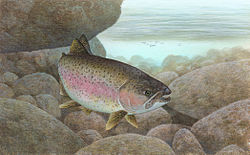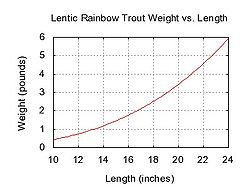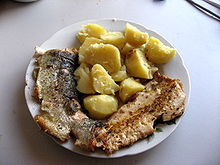- Rainbow trout
-
"Steelhead" redirects here. For other uses, see Steelhead (disambiguation).
Rainbow trout 
Scientific classification Kingdom: Animalia Phylum: Chordata Class: Actinopterygii Subclass: Neopterygii Infraclass: Teleostei Order: Salmoniformes Family: Salmonidae Genus: Oncorhynchus Species: O. mykiss Binomial name Oncorhynchus mykiss
Walbaum, 1792Subspecies See text
The rainbow trout (Oncorhynchus mykiss) is a species of salmonid native to tributaries of the Pacific Ocean in Asia and North America. The steelhead is a sea run rainbow trout (anadromous) usually returning to freshwater to spawn after 2 to 3 years at sea. In other words, rainbow trout and steelhead trout are the same species. The fish are often called salmon trout.[1] Several other fish in the salmonid family are called trout, some are anadromous like salmon, whereas others are resident in freshwater only.[2]
The species has been introduced for food or sport to at least 45 countries, and every continent except Antarctica. In some locations, such as Southern Europe, Australia and South America, they have negatively impacted upland native fish species, either by eating them, outcompeting them, transmitting contagious diseases, (like Whirling disease transmitted by Tubifex) or hybridization with closely related species and subspecies that are native to western North America.[3][4]
Contents
Taxonomy
The species was originally named by Johann Julius Walbaum in 1792 based on type specimens from Kamchatka. Richardson named a specimen of this species Salmo gairdneri in 1836, and in 1855, W. P. Gibbons found a population and named it Salmo iridia, later corrected to Salmo irideus, however these names faded once it was determined that Walbaum's type description was conspecific and therefore had precedence (see e.g. Behnke, 1966).[5] More recently, DNA studies showed rainbow trout are genetically closer to Pacific salmon (Onchorhynchus species) than to brown trout (Salmo trutta) or Atlantic Salmon (Salmo salar), so the genus was changed.
Unlike the species' former name's epithet iridia (Latin: rainbow), the specific epithet mykiss derives from the local Kamchatkan name 'mykizha'; all of Walbaum's species names were based on Kamchatkan local names.
The ocean going (anadromous) form (including those returning for spawning) are known as steelhead, (Canada and the United States) or ocean trout (Australia), although they are the same species.
Life cycle
Like salmon, steelhead are anadromous: they return to their original hatching ground to spawn. Similar to Atlantic salmon, but unlike their Pacific Oncorhynchus salmonid kin, steelhead are iteroparous (able to spawn several times, each time separated by months) and make several spawning trips between fresh and salt water. The steelhead smolts (immature or young fish) remain in the river for about a year before heading to sea, whereas salmon typically return to the seas as smolts. Different steelhead populations migrate upriver at different times of the year. "Summer-run steelhead" migrate between May and October, before their reproductive organs are fully mature. They mature in freshwater before spawning in the spring. Most Columbia River steelhead are "summer-run". "Winter-run steelhead" mature fully in the ocean before migrating, between November and April, and spawn shortly after returning. The maximum recorded life-span for a rainbow trout is 11 years.[6]
Feeding
Rainbow trout are predators with a varied diet, and will eat nearly anything they can grab. Their image as a selective eater is only a legend. Rainbows are not quite as piscivorous or aggressive as brown trout or lake trout (char). Young rainbows survive on insects, fish eggs, smaller fish (up to 1/3 of their length), along with crayfish and other crustaceans. As they grow, though, the proportion of fish increases in most all populations. Some lake dwelling lines may become planktonic feeders. While in flowing waters populated with salmonids, trout eat varied fish eggs, including salmon, cutthroat trout, as well as the eggs of other rainbow trout, alevin, fry, smolt and even left-over carcasses.
Length and Weight
As rainbow trout grow, they lengthen and increase in mass. The relationship between length and mass is not linear. The relationship between total length (L, in inches) and total mass (W, in pounds) for steelhead and nearly all other fish can be expressed by an equation of the form:
b is close to 3.0 for all species, and c is a constant that varies among species. For lentic rainbow trout, b = 2.990 and c = 0.000426, and for lotic rainbow trout, b = 3.024 and c = 0.000370.[7]
The relationship described in this section suggests that a 13 in (33 cm) lentic rainbow trout weighs about 1 lb (0.45 kg), while an 18 in (46 cm) lentic rainbow trout weighs about 2.5 lb (1.1 kg).
Threats and conservation
Steelhead trout populations have declined due to human and natural causes. Steelhead (Oncorhynchus mykiss) historically occurred around the North Pacific Ocean from northwestern Mexico in North America to eastern Russia in Asia.[8]
Two West Coast Evolutionarily Significant Units (ESUs) are endangered under the Federal Endangered Species Act (Southern California and Upper Columbia River) and eight ESUs are threatened.[9] The U.S. National Marine Fisheries Service has a detailed description of threats. Southern California (south of Point Conception) ESU steelhead have been affected by habitat loss due to dams, confinement of streams in concrete channels, water pollution, groundwater pumping, urban heat island effects, and other byproducts of urbanization.
Several studies have shown that almost all California coastal steelhead are of native origin, despite over a century of hatchery stocking. Genetic analysis shows that South Central California Coast (SCCC) Distinct population segment (DPS) and Southern California (SC) DPS from Malibu Creek north, and including the San Gabriel River, Santa Ana River and San Mateo Creek, are not hatchery strains. However, steelhead from Topanga Creek and the Sweetwater River were partly, and from San Juan Creek completely, of hatchery origin.[8] Genetic analysis has also shown that steelhead in the streams of the Santa Clara County and Monterey Bay basins are not of hatchery origin, including the Coyote Creek, Guadalupe River, Pajaro River, Permanente Creek, Stevens Creek, San Francisquito Creek, San Lorenzo River, and San Tomas Aquino Creek basins.[10] Natural waterfalls and two major dams have isolated Russian River anadromous steelhead from its non-ocean going rainbow trout form above the impassable barriers, however a recent genetic study of fin samples collected from steelhead at 20 different sites both above and below passage barriers in the watershed found that despite the fact that 30 million hatchery trout were stocked in the river from 1911 to 1925, the steelhead remain of native and not hatchery stock.[11]
The rainbow trout is susceptible to enteric redmouth disease. There has been considerable research conducted on redmouth disease, given its serious implications for rainbow trout farmers. The disease does not affect humans.[12]
The U.S. National Marine Fisheries Service has identified 15 populations, called Distinct Population Segments(DPSs), in Washington, Oregon and California.[13][14] Eleven of these DPSs are listed under the U.S. Endangered Species Act (ESA).[15] One DPS on the Oregon Coast is designated a U.S. Species of Concern. Species of Concern are those species that lack sufficient data to determine whether to list the species under the ESA.
Rainbow trout, and subspecies thereof, are currently EPA approved indicator species for acute fresh water toxicity testing.[16]
In 2010, the Oregon Department of Fish & Wildlife hatchery expects to more than double its take over 2009. The 2009 population grew 60% over 2008. Hatchery-taken fish will spawn tens of thousands of juvenile "smolts" that will be released to swim downstream and mature in the Pacific.[17]
In March 2010, the Los Angeles Times reported that the New Zealand mud snail had infested watersheds in the Santa Monica Mountains, complicating efforts to improve stream-water quality for the steelhead. According to the article, the snails have expanded "from the first confirmed sample in Medea Creek in Agoura Hills to nearly 30 other stream sites in four years." Researchers at the Santa Monica Bay Restoration Commission believe that the snails' expansion may have been expedited after the mollusks traveled from stream to stream on the gear of contractors and volunteers.[18]
Hatcheries have also been demonstrated to present a risk to wild steelhead populations. Releases of conventionally reared hatchery steelhead pose ecological risks to preexisting wild steelhead populations. Hatchery steelhead are typically larger than the wild form and can displace wild form juveniles from optimal habitat. Dominance of hatchery steelhead for optimal microhabitats within streams may reduce wild steelhead survival as a result of reduced foraging opportunity and increased rates of predation. [19]
Gallery
Relation to humans
Fishing
Rainbow trout and steelhead are both highly desired food and sportfish. A number of angling methods are common. Rainbow trout are a popular target for fly fishers. Spinners, spoons, and small crankbaits can also be used productively, either casting or trolling. Rainbow trout can also be caught on live bait; nightcrawlers, trout worms, and minnows are popular and effective choices. The IGFA recognizes the world record for Rainbow Trout was caught on Saskatchewan's Lake Diefenbaker by Sean Konrad on September 5 2009. The fish weighed 48 lb 0 oz (21.77 kg).
Hatcheries and farms
 Rainbow trout, cleaned and iced, in a fish market in Western Australia
Rainbow trout, cleaned and iced, in a fish market in Western Australia
The first rainbow trout hatchery was established on San Leandro Creek, a tributary of San Francisco Bay, in 1870 with trout production beginning in 1871. The hatchery was stocked with the locally native rainbow trout, and likely steelhead. The fish raised in this hatchery were shipped to hatcheries out of state for the first time in 1875, to Caledonia, New York[disambiguation needed
 ] and then in 1876 to Northville, Michigan. In 1877, another rainbow trout hatchery was established on Campbell Creek, a McCloud River tributary. However, the McCloud River stock indiscriminately mixed rainbow trout with Redband trout (Oncorhynchus mykiss stonei).[20]
] and then in 1876 to Northville, Michigan. In 1877, another rainbow trout hatchery was established on Campbell Creek, a McCloud River tributary. However, the McCloud River stock indiscriminately mixed rainbow trout with Redband trout (Oncorhynchus mykiss stonei).[20]They are farmed in many countries throughout the world. Since the 1950s commercial production has grown exponentially,[21] particularly in Europe and recently in Chile. Worldwide, in 2007, 604,695 tonnes (595,145 long tons; 666,562 short tons) of farmed salmon trout were harvested with a value of 2.589 billion US dollars.[22] The largest producer is Chile. In Chile and Norway, ocean cage production of steelhead has expanded to supply export markets. Inland production of rainbow trout to supply domestic markets has increased in countries such as Italy, France, Germany, Denmark and Spain. Other significant producing countries include the USA, Iran, Germany and the United Kingdom.[22]
There are tribal commercial fisheries for steelhead in Puget Sound, the Washington Coast and in the Columbia River.
Cultivated varieties
Golden rainbow trout are bred from a single mutated color variant of Oncorhynchus mykiss.[23] Golden rainbow trout are predominantly yellowish, lacking the typical green field and black spots, but retaining the diffuse red stripe.[23][24] The palomino trout is a mix of golden and common rainbow trout, resulting in an intermediate color. The golden rainbow trout should not be confused with the naturally occurring golden trout.
As food
Rainbow trout is popular in Western cuisine and is caught wild and farmed. It has tender flesh and a mild, somewhat nutty flavor. However, farmed trout and those taken from certain lakes have a pronounced earthy flavor which many people find unappealing; many shoppers therefore ascertain the source of the fish before buying. Wild rainbow trout that eat scuds (freshwater shrimp), insects such as flies, and crayfish are the most appealing. Dark red/orange meat indicates that it is either an anadromous steelhead or a farmed Rainbow trout given a supplemental diet with a high astaxanthin content. The resulting pink flesh is marketed under monikers like Ruby Red or Carolina Red.
Steelhead meat is pink like that of salmon, and is more flavorful than the light-colored meat of rainbow trout.[25]
Medicine
The sperm of rainbow trout contains protamine, which counters the anticoagulant heparin. Protamine was originally isolated from fish sperm, but is now produced synthetically.
Subspecies
A few populations are recognized as subspecies:
- Kamchatkan rainbow trout, Oncorhynchus mykiss mykiss (Walbaum, 1792).
- Columbia River redband trout, Oncorhynchus mykiss gairdnerii (Richardson, 1836).
- Coastal rainbow trout/Steelhead trout, Oncorhynchus mykiss irideus (Gibbons, 1855).
- Beardslee trout, isolated in Lake Crescent (Washington), Oncorhynchus mykiss irideus var. beardsleei (not a true subspecies, but a lake dwelling variety of Coastal rainbow trout)[citation needed] (Jordan, 1896).
- Great Basin redband trout, Oncorhynchus mykiss newberrii (Girard, 1859).
- Golden trout, Oncorhynchus mykiss aguabonita (Jordan, 1892).
- Kamloops rainbow trout, Oncorhynchus mykiss kamloops (Jordan, 1892).
- Kern River rainbow trout, Oncorhynchus mykiss aguabonita var. gilberti (Jordan, 1894).
- Sacramento golden trout, Oncorhynchus mykiss aguabonita var. stonei (Jordan, 1894).
- Little Kern golden trout, Oncorhynchus mykiss aguabonita var. whitei (Evermann, 1906).
- Baja California rainbow trout, Nelson's trout, or San Pedro Martir trout, Oncorhynchus mykiss nelsoni (Evermann, 1908).
- Eagle Lake trout, Oncorhynchus mykiss aquilarum (Snyder, 1917).
- McCloud River redband, Oncorhynchus mykiss stonei
- Sheepheaven Creek redband, Oncorhynchus mykiss spp.
- Southern California Steelhead DPS, Oncorhynchus mykiss
See also
- Cutbow
- Fly fishing
- Golden trout
- Sport fishing
- Trout worms
Notes
- ^ "Salmon Trout". Lewis and Clark Fort Mandan Foundation. http://lewis-clark.org/content/content-article.asp?ArticleID=1931. Retrieved 2010-10-23.
- ^ Trey Coombs (1999). Steelhead Fly Fishing. Globe Pequot. p. 5. ISBN 9781558219038. http://books.google.com/books?id=MsiVifvRBlQC&pg=PA5&lpg=PA5&dq=steelhead+san+leandro&source=bl&ots=AL7G0iDrL9&sig=Ig5c44TEW568OzK6QVVkX3d9ebQ&hl=en&ei=7J3DTNLpFIe8sAPN8Z2hDA&sa=X&oi=book_result&ct=result&resnum=6&ved=0CCwQ6AEwBQ#v=onepage&q=steelhead%20san%20leandro&f=false. Retrieved 2010-10-23.
- ^ Salmo marmoratus
- ^ Salmothymus obtusirostris salonitana
- ^ Robert J. Behnke. 1966. Relationships of the Far Eastern Trout, Salmo mykiss walbaum Copeia, Vol. 1966, No. 2 (June 21, 1966), pp. 346–348
- ^ Froese, Rainer, and Daniel Pauly, eds. (2006). "Oncorhynchus mykiss" in FishBase. February 2006 version.
- ^ R. O. Anderson and R. M. Neumann, Length, Weight, and Associated Structural Indices, in Fisheries Techniques, second edition, B.E. Murphy and D.W. Willis, eds., American Fisheries Society, 1996.
- ^ a b Anthony J. Clemento, Eric C. Anderson, David Boughton, Derek Girman, John Carlos Garza (2009). "Population genetic structure and ancestry of Oncorhynchus mykiss populations above and below dams in south-central California". Conservation Genetics: 1321–1336. http://www.springerlink.com/content/7305l85175847n20/fulltext.pdf. Retrieved 2011-06-11.
- ^ "Map showing endangered species status of west coast steelhead". Alameda Creek Alliance. http://www.alamedacreek.org/Steelhead%20trout/steelhead%20listing%20status.gif. Retrieved FEb. 14, 2010.
- ^ John Carlos Garza, Devon Pearse (2008-03). Population genetics of Oncorhynchus mykiss in the Santa Clara Valley Region, Final Report to the Santa Clara Valley Water District (Report). Santa Clara Valley Water District. pp. 1-54.
- ^ Kristy Deiner, John Carlos Garza, Robert Coey, Derek J. Girman (2007). "Population structure and genetic diversity of trout (Oncorhynchus mykiss) above and below natural and man-made barriers in the Russian River, California". Conservation Genetics: 437–454. http://www.springerlink.com/content/f3878004u22g2165/fulltext.pdf. Retrieved 2011-06-12.
- ^ LSC - Fish Disease Leaflet 82
- ^ "Distinct Population Segments". U.S. National Marine Fisheries Service. http://www.nmfs.noaa.gov/pr/glossary.htm#dps.
- ^ "Steelhead Distinct Population Segments". U.S. National Marine Fisheries Service. http://www.nwr.noaa.gov/ESA-Salmon-Listings/Salmon-Populations/Steelhead/.
- ^ "Endangered Species Act". http://www.nmfs.noaa.gov/pr/laws/esa/.
- ^ EPA Whole Effluent Toxicity
- ^ Millman, Joel (January 21, 2010). "Fish Boom Makes Splash in Oregon". Wall Street Journal. http://online.wsj.com/article/SB10001424052748703657604575005562712284770.html. Retrieved January 21, 2010.
- ^ Hard-to-kill snails infest Santa Monica Mountain watersheds Even Formula 409 has proven ineffective at destroying the New Zealand mudsnail, an asexually reproducing invasive species that poses a threat to steelhead restoration efforts and native creatures.
- ^ McMichael, G. A., T. N. Pearsons, and S. A. Leider. 1999. Behavioral interactions among hatchery-reared steelhead smolts and wild Oncorhynchus mykiss in natural streams. North American Journal of Fisheries Management 19: 948-956
- ^ Robert J. Behnke, Ted Williams (2007). About Trout: The Best of Robert J. Behnke from Trout Magazine. Globe Pequot. p. 6. ISBN 9781599212036. http://books.google.com/books?id=SpNwYrhbWVgC&pg=PA6&lpg=PA6&dq=rainbow+trout+San+Leandro+Creek&source=bl&ots=m87akJcIDT&sig=uwa-rjB4gy20vygNx8-sBaDPWWs&hl=en&ei=f90mS9WzO4S-sgOf5fCfDA&sa=X&oi=book_result&ct=result&resnum=4&ved=0CBIQ6AEwAw#v=onepage&q=rainbow%20trout%20San%20Leandro%20Creek&f=false. Retrieved 2011-05-03.
- ^ Cowx, I.G. Cultured Aquatic Species Information Programme Oncorhynchus mykiss Walbaum, 1792 (Salmonidae) Rainbow Trout Food and Agricultural Organisation of the United Nations Fisheries snd Aquaculture Department (online), Rome, Updated 15 June 2005, Retrieved 27 September 2010
- ^ a b FAO: Species Fact Sheets: Oncorhynchus mykiss (Walbaum, 1792) Rome. Accessed 9 May 2009.
- ^ a b Golden Rainbow Trout. Pennsylvania Fish & Boat Commission FAQ.
- ^ Golden Rainbow Trout. Photo.
- ^ Your Christmas Steelhead
References
- Froese, Rainer, and Daniel Pauly, eds. (2006). "Oncorhynchus mykiss" in FishBase. February 2006 version.
- Halverson, Anders (2010) An Entirely Synthetic Fish: How Rainbow Trout Beguiled America and Overran the World Yale University Press, ISBN 978-0300140880. Review Interviews
- "Oncorhynchus mykiss". Integrated Taxonomic Information System. http://www.itis.gov/servlet/SingleRpt/SingleRpt?search_topic=TSN&search_value=161989. Retrieved 30 January 2006.
- Scott and Crossman (1985) Freshwater Fishes of Canada. Bulletin 184. Fisheries Research Board of Canada. Page 189. ISBN 0-660-10239-0
External links
- [1] IGFA World Record for Rainbow Trout
- Map showing endangered species status of West Coast steelhead
- Association of Northwest Steelheaders
- Fish-On! - Full Rainbow Trout Chapter at TheFishingNetwork.com
- Rainbow trout page from the Alaska Department of Fish and Game
- Rainbow trout information from Northern State University
- Australian Aquaculture Portal
- Fishbase.org article on Oncorhynchus mykiss, Rainbow trout
- Kenai River, Alaska Rainbow Trout Fact Page
- ZipcodeZoo fact page
- Season/Timing information for Steelhead in the Great Lakes region
- [2] Huge Alaska Rainbow Trout Photo Page
- Alaska Department of Fish and Game article on life cycle and conservation of Steelhead/Rainbow Trout
- Fishing the North Platte River
- GLANSIS Species FactSheet
Principal commercial fishery species groups Wild Forage fishOther wild fishMolluscs- Sea cucumbers
- Sea urchin
- more...



Farmed Categories:- Fishes articles needing expert attention
- Oncorhynchus
- Cold water fish
- Fish of the Pacific Ocean
- Fish of the Western United States
- Fish of the Great Lakes
- Fauna of the Rocky Mountains
- Fauna of Canada
- Fish of Pakistan
- Introduced freshwater fish of Australia
- Introduced freshwater fish of New Zealand
- Introduced freshwater fish of South Africa
- Animals described in 1792
- Invasive fish species
- Commercial fish
- Fly fishing target species
Wikimedia Foundation. 2010.








